Ditapis dengan

Ringkasan Eksekutif Hasil Kajian Kecukupan Paket Manfaat JKN Bagi Peserta Pen…
Penyandang disabilitas di Indonesia sering menghadapi tantangan besar dalam mengakses layanan kesehatan yang memadai. Data Susenans 2023 menunjukkan bahwa sekitar 48,8% penyandang disabilitas memiliki keluhan kesehatan dalam sebulan terakhir, jauh lebih tinggi dibandingkan dengan 24,6% non-penyandang disabilitas. Selain itu, 28% penyandang disabilitas tidak memiliki Jaminan Kesehatan Nasional (…
- Edisi
- -
- ISBN/ISSN
- -
- Deskripsi Fisik
- 16 Halaman: 29 cm, PDF
- Judul Seri
- -
- No. Panggil
- 368.3 DWI r
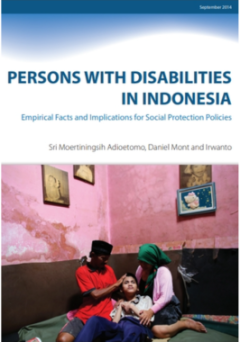
Persons With Disabilities In Indonesia: Empirical Facts And Implications For …
The issue of disability is complex and wide ranging, and although much evidence exists globally about its connection to poverty, this report serves as the first truly comprehensive look at disability in Indonesia. Utilising previously collected data from the National Basic Health Research (Riset Kesehatan Dasar or Riskesdas) 2007 and the Indonesian Population Census 2010, this report explores t…
- Edisi
- 1
- ISBN/ISSN
- 9786022751229
- Deskripsi Fisik
- xviii, 193 Halaman ; 29 cm, PDF
- Judul Seri
- Textbook dan Ebook
- No. Panggil
- 362.4 SRI p
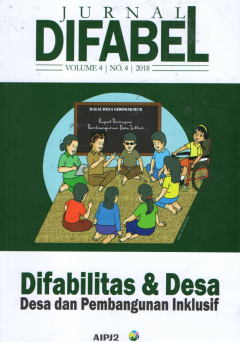
Jurnal Difabel Volume 4 | No. 4 | 2018
Jurnal Difabel Volume 4, No. 4, Tahun 2018, memuat berbagai artikel yang membahas isu-isu terkait disabilitas dari berbagai perspektif, termasuk sosial, pendidikan, kebijakan, dan hak asasi manusia. Edisi ini berfokus pada pemahaman yang lebih mendalam tentang tantangan yang dihadapi oleh penyandang disabilitas serta upaya untuk meningkatkan inklusivitas dan kesejahteraan mereka dalam masyarakat.
- Edisi
- Volume 4 | No. 4 | 2018
- ISBN/ISSN
- 9772460603008 / 2460-6030
- Deskripsi Fisik
- x + 154 halaman
- Judul Seri
- Textbook
- No. Panggil
- 300.5 JUR j

The Life Of People With Disabilities An Introduction To The Survey On The Nee…
In 2012, the Demographic Institute of the University of Indonesia conducted on behalf of TNP2K a unique survey on disability that sheds new light on the needs and living conditions of people with disabilities (PWDs) in Indonesia. This new dataset is called the Survey on the Need for Social Assistance Programmes for People with Disabilities (SNSAP-PWD 2012) and is available free of charge from T…
- Edisi
- TNP2K Working Paper 08 – 2014
- ISBN/ISSN
- -
- Deskripsi Fisik
- vii, 9 Halaman, PDF
- Judul Seri
- Working Paper
- No. Panggil
- 362.4 PRI t
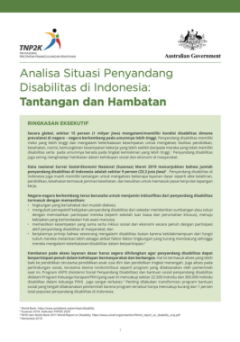
Analisa Situasi Penyandang Disabilitas di Indonesia: Tantangan dan Hambatan
Penyandang disabilitas di Indonesia tidak hanya menghadapi risiko ekonomi dan finansial yang besar, tetapi juga menghadapi tantangan besar dalam mengakses fasilitas dan layanan kesehatan serta pendidikan, perlindungan sosial dan memasuki pasar tenaga kerja. Sejak tahun 2018, Survei Sosial Ekonomi Nasional (Susenas) telah secara konsisten memasukkan Pertanyaan Disabilitas Kelompok Washington5 ya…
- Edisi
- 1
- ISBN/ISSN
- -
- Deskripsi Fisik
- PDF, 16 Halaman
- Judul Seri
- Policy Brief
- No. Panggil
- 371.9 SIY.A
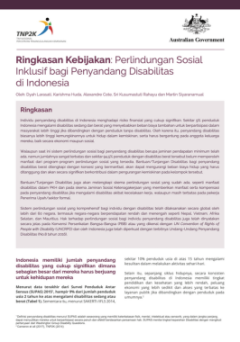
Ringkasan Kebijakan: Perlindungan Sosial Inklusif bagi Penyandang Disabilita…
Individu penyandang disabilitas di Indonesia menghadapi risiko finansial yang cukup signifikan. Sekitar 9% penduduk Indonesia mengalami disabilitas sedang dan berat yang menyebabkan beban biaya tambahan untuk berpartisipasi dalam masyarakat lebih tinggi jika dibandingkan dengan penduduk tanpa disabilitas. Oleh karena itu, penyandang disabilitas biasanya lebih tinggi kemungkinannya untuk hidup d…
- Edisi
- 1
- ISBN/ISSN
- -
- Deskripsi Fisik
- PDF, 8 Halaman
- Judul Seri
- Policy Brief
- No. Panggil
- 371.9
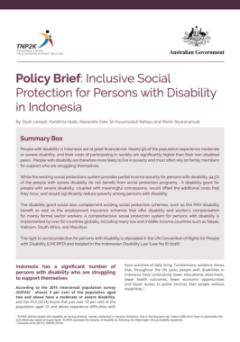
Policy Brief: Inclusive Social Protection for Persons with Disability in In…
According to the 2015 intercensal population survey (SUPAS)1 almost 9 per cent of the population aged two and above have a moderate or severe disability, and the IFLS (2014) found that just over 10 per cent of the population aged 15 and above experience difficulties with basic activities of daily living. Furthermore, evidence shows that, throughout the life cycle, people with disabilities in In…
- Edisi
- 1
- ISBN/ISSN
- -
- Deskripsi Fisik
- PDF, 8 Halaman
- Judul Seri
- Policy Brief
- No. Panggil
- 371.9 LAR.P

Economic Impacts and Access to Social Protection during the COVID-19 Crisis: …
The COVID-19 pandemic is expected to result in a rapid and significant increase in the prevalence and severity of poverty in Indonesia, as people are unable to work, jobs and income are lost, businesses close and debts accumulate. Under the most recent projection, COVID-19 could push between 1.3 million to 8.5 million people into poverty, significantly increasing the national poverty rate (SMER…
- Edisi
- 1
- ISBN/ISSN
- -
- Deskripsi Fisik
- PDF, 12 Halaman
- Judul Seri
- Policy Brief
- No. Panggil
- 371.9 MAH.E

Disability Situation Analysis Challenges and Barriers for People with Disabi…
People with disability in Indonesia are not only at great economic and financial risk but are also facing great challenges in accessing health and education facilities and services, social protection, and in entering the labour market. In 2018, the Indonesia National Socio-Economic Survey (Susenas) included the Washington Group Disability Questions Set5 which aims to provide the most updated in…
- Edisi
- 1
- ISBN/ISSN
- -
- Deskripsi Fisik
- PDF, 16 Halaman
- Judul Seri
- Policy Brief
- No. Panggil
- 371.9 SIY.D
 Karya Umum
Karya Umum  Filsafat
Filsafat  Agama
Agama  Ilmu-ilmu Sosial
Ilmu-ilmu Sosial  Bahasa
Bahasa  Ilmu-ilmu Murni
Ilmu-ilmu Murni  Ilmu-ilmu Terapan
Ilmu-ilmu Terapan  Kesenian, Hiburan, dan Olahraga
Kesenian, Hiburan, dan Olahraga  Kesusastraan
Kesusastraan  Geografi dan Sejarah
Geografi dan Sejarah